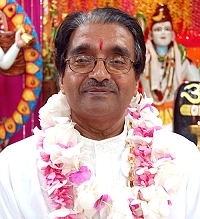From a satsang with Paramacharya of SWAHA, H.H. Pundit Hardeo Persad
Most Hindus are familiar with the revered story of Shri Krishna and Mount Goverdhan. In this divine play, Shri Krishna protects the villagers of Vraj from Lord Indra’s torrential downpour by lifting Mount Goverdhan with the little finger of his left hand, offering them shelter. Known as Goverdhan Giridhaari, he champions the cause of his devotees, guiding them through times of peril. This sacred event is commemorated the day after Divali through the ritual of Goverdhan puja.
This eternal katha encodes profound metaphysical teachings that resonate within each of us. To understand its inner meaning, we must recognise that Mt. Goverdhan symbolises the mountain of yoga—an ascent toward mental and spiritual elevation. The very name ‘Goverdhan’ reveals this deeper truth: ‘Go’ signifies the senses, ‘var’ denotes a boon, and ‘dhan’ represents wealth. Thus, mastering the senses is the true treasure of spiritual life. Shri Krishna, the supreme Mahayogi, stands as the embodiment of yoga. Lifting the mountain signifies raising our consciousness to the eternal principles residing within our being.
However, this inner mountain is often submerged by the turbulent waters of sensory distractions. True spiritual advancement requires transcending the attractions and aversions of the gross senses. The mountain of yoga, the union with the Divine, resides in each of us. The ultimate aim of all religious practices is to unite the atma, or individual soul, with the Paramatma, the Divine Soul. Through religious rituals infused with understanding, we can elevate ourselves spiritually.
The symbolism extends further: the five fingers of the hand represent key aspects of existence. The thumb embodies Brahm (the Supreme Being), the index finger represents jiva (the individual soul), the middle finger symbolises sattva (purity and righteousness), the ring finger denotes rajas (activity and materialism), and the little finger corresponds to tamas (stillness and oneness). Yogis use their fingers in various mudras (spiritual hand gestures) to direct energy and intention. When the index finger joins with the thumb, it represents the soul merging with the Divine, transcending the three gunas (modes of existence). Tamas, the state of inner stillness, is crucial for uplifting the mountain of yoga—our minds must stabilise in this state to rise above materialistic distractions.
In a more subtle sense, the mountain also symbolises the spine, the centre of spiritual energy. Within each of us flow three vital energy channels—the Ida, Pingala and Sushumna Naadis—paralleling the sacred rivers Ganga, Yamuna and the hidden Saraswati. These channels converge at the ajna chakra, located in the forehead, mirroring the Triveni confluence of rivers in India. As we activate the seven chakras, or energy centres, we awaken the dormant Kundalini Shakti, the spiritual force at the base of the spine.
Our bodies themselves house the divine forces. The sun, the moon and the trinity of Brahma, Vishnu and Shiva reside within us as the atma or soul. Shri Krishna, in the Bhagavad Gita, Chapter 13, declares, “I am the soul in each person.” It is through the inward turning of the senses, the indriyas, that we unlock this divine potential. This is the universal message of Goverdhan puja. When we worship Goverdhan, the intellect is purified, the senses rise above the waters of sensuality, and the mountain of yoga is elevated. Shri Krishna’s katha beckons us to turn inward, discover eternal truths and understand the mysteries of the universe by first understanding the divine nature within ourselves. Let us pray for the grace of Shri Krishna to uplift the Goverdhan within each of us.

